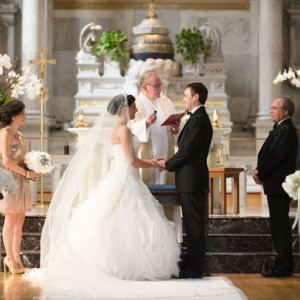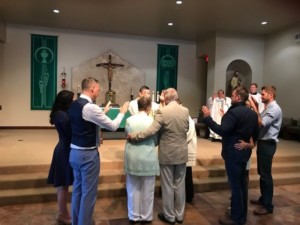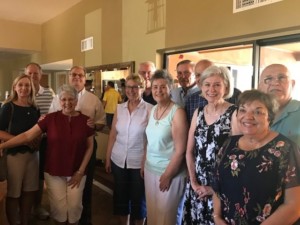Welcome to TOB Tuesdays Refreshed. Over the next few months we will revisit Katrina’s past blogs followed by Jack Henz’* reflection.
Can We Lose Our Virginity? by Katrina J. Zeno, MTS
Our previous exploration into the Virginal life of the Trinity may have been jarring and even mystifying for some. I agree. I never imagined my adult life would be dedicated to exploring virginity in the Trinity along with human perfection in virginity – and then trying to communicate these truths to others. What a crazy mission! In fact, whenever I speak on these topics, I see people’s facial expressions and body language immediately express doubt and resistance. We’ve been trained our whole lives to think we lose our virginity.
And now St. JPII asks us to think of virginity as present our whole life long until it is perfected in heaven. This is akin to thinking of the earth as flat our whole life long and then suddenly having someone claim it is round. We have no place in our brain to store this radical paradigm shift.
But true Christianity is a radical paradigm shift – the paradigm shift from God being One to also being Three; from God being purely spiritual to also being incarnate; from the resurrection of the soul to the resurrection of the human body. To this wonderful list we can add eternal salvation as being both spousal and virginal: we behold God face to face, and we also receive God’s gift of self into our virginally perfected body for all eternity (see Blog #15 on “Star Trek and Virginal Divinization”).
This brings us to another aspect of Catholic Church teaching that often seems peripheral and irrelevant to everyday life – Mary’s perpetual virginity. Far from being disconnected from our everyday lives, Mary’s perpetual virginity is essential. Her perpetual virginity reveals our perpetual virginity.
Far from being disconnected from our everyday lives, Mary’s perpetual virginity is essential. Her perpetual virginity reveals our perpetual virginity.
It sounds bizarre, doesn’t it? Who would ever describe the ultimate end, goal, and purpose of human life as perpetual virginity? The answer, of course, is St. John Paul II, who seemingly pushes our understanding of virginity to its limit. In TOB A71:5, he writes, “The words of Christ…open before us the prospect of the body’s eschatological perfection fully submitted to the divinizing depth of the vision of God ‘face to face,’ which is the inexhaustible source of both perpetual ‘virginity’ (united with the spousal meaning of the body) and perpetual ‘intersubjectivity’ of all human beings who will share (as male and female) in the resurrection.”
 In heaven, you, like Mary, will be perpetually virgin. Your body’s capacity to be totally available for union will be fully engaged by being united in perfect virginal union with God. And because you and all the saints are in perfect virginal union and communion with the Trinity, then we will be in perfect virginal union and communion with each other. This is what we commonly call the “Communion of Saints” and what St. JPII refers to as the “perpetual intersubjectivity of all human beings.”
In heaven, you, like Mary, will be perpetually virgin. Your body’s capacity to be totally available for union will be fully engaged by being united in perfect virginal union with God. And because you and all the saints are in perfect virginal union and communion with the Trinity, then we will be in perfect virginal union and communion with each other. This is what we commonly call the “Communion of Saints” and what St. JPII refers to as the “perpetual intersubjectivity of all human beings.”
From this reality of perpetual virginity, we can conclude a significant fact for our life here and now – on earth, we don’t “lose” our virginity since we would never want to “lose” or even damage our capacity for being totally available for union and communion. On the contrary, when living according to God’s plan, we constantly expand and fulfill our virginity – even in marriage.
I once had a conference participant in Lubbock, Texas, share her wedding-night struggles with me. Her family drilled into her that sex before marriage was bad and that losing her virginity before marriage was a sin. Then, when her wedding night arrived, she experienced an intense, internal conflict: After protecting her virginity for many years, how did she suddenly flip a switch and say it was okay to “lose” her virginity?
However, when she heard my definition of a virgin as someone totally available for union, a profound interior switch indeed occurred. To her great relief, she realized she didn’t “lose” her virginity on her wedding night, but actualized it. Protecting her virginity all those years wasn’t supposed to make her repressed and rigid. Rather, it prepared her to be open and uniquely receptive to union and communion with this one, particular person – her husband. And in doing so, her virginity was put at the service of a very beautiful reality – the creation of the conjugal, covenant bond.
In my experience of asking thousands of people about the visible sign and invisible reality present in various Sacraments, marriage repeatedly gets the short stick. Most Catholics can identify the visible signs of Baptism and the Eucharist as easily as their own names: water for Baptism and bread and wine for the Eucharist.
They can also quickly name the invisible reality – that is, the action occurring supernaturally in the celebration of the Sacrament that we cannot see but we know is taking place. In Baptism, original sin is being washed away, the Holy Spirit comes to dwell within, and we are united to the Body of Christ so that we now participate in Divine Life (see Blog 14). In the Eucharist, the invisible reality is the Glorified Body and Blood of Christ. Check, check: we know our catechism.
But when it comes to marriage, which is the sacramental vocation most people are gifted with, a catechetical gap suddenly appears. Many people identify the rings as the visible sign in marriage, but this is incorrect. Rings are a beautiful enhancement to a marriage, but they are not essential to its celebration. Marriage can be validly celebrated without rings, thus it is not the “matter” or visible sign of the Sacrament.
On the contrary, the “matter” of water is absolutely necessary to celebrate a valid Baptism. Neither motor oil nor orange Koolaid can be used in its place. Likewise, bread and wine are essential for the celebration of the Eucharist. Potato chips and coke can’t be substituted as valid “matter.” Why not?
Because the matter matters. Water is used in Baptism because of its natural ability to symbolize cleansing and new life. If water disappeared from our planet, eventually everything would be dirty and dead. In the Eucharist, bread and wine are used to symbolize not only nourishment, but the many becoming one (union and communion!). The many grains of wheat are crushed to make the bread; the many grapes are crushed to make the wine. The natural structure of the bread and wine symbolizes how we, though many, become one Body in Christ through the Eucharist. Inversely, potato chips represent the opposite reality – the one potato is sliced into many pieces. Potato chips contradict what the natural symbol is meant to represent.
 This short explanation on why the matter matters in each Sacrament provides the necessary framework for understanding the sacramental sign of marriage. As already mentioned, the rings are not the “matter” of the sacramental sign. Rather, the bride and groom themselves are the “matter” of the Sacrament. They, along with the vows, are the natural symbols that represent the invisible reality of the Sacrament of marriage.
This short explanation on why the matter matters in each Sacrament provides the necessary framework for understanding the sacramental sign of marriage. As already mentioned, the rings are not the “matter” of the sacramental sign. Rather, the bride and groom themselves are the “matter” of the Sacrament. They, along with the vows, are the natural symbols that represent the invisible reality of the Sacrament of marriage.
Which leads to the most critical question of all: What is the invisible reality of marriage? When the man and woman pronounce their vows, something occurs supernaturally that we cannot see – and this supernatural reality defines the nature of marriage. What is it?
I find this question stumps most people, and indeed, I remained ignorant of the answer until my early 50s when studying for my master’s degree in theology. I always assumed the supernatural reality of marriage was husband and wife imaging Christ’s love for the Church. While this is true, this is a fruit of the Sacrament, not its interior, organizing structure. The invisible reality of marriage is the supernatural conjugal bond.
Here’s the way I picture this reality in my mind: When husband and wife profess their vows, God receives their free consent and supernaturally binds the man and woman together in an indissoluble conjugal bond. Jesus himself revealed this divine involvement in marriage when he declared: “What God has joined, man must not divide.”
Fr. Raniero Cantalamessa, the preacher to the papal household, insightfully describes this divine action when he says, “With the words ‘What therefore God has joined together, let not man put asunder,’ Jesus affirms that there is divine intervention by God in every matrimonial union” (cf. 2016 Fourth Lenten Homily).
At this moment, when husband and wife are joined indissolubly in the supernatural conjugal bond by divine intervention, are they two or are they one? The answer is, “Both!”
Marriage – like the Incarnation, the Eucharist, and our ultimate destiny in heaven – is a union in communion, a unity in distinction.
Marriage – like the Incarnation, the Eucharist, and our ultimate destiny in heaven – is a union in communion, a unity in distinction. Marriage is not a fusion. Husband and wife do not dissolve into one another thus losing their individual identities and uniqueness. Neither is marriage a legally sanctioned cohabitation where husband and wife are joined together like two Lego pieces that can be separated at any time. Instead, a new, indissoluble reality comes into existence where each person is fully him or herself and yet fully united to the other. They become what I like to call a “we-person.”
Let’s make this simple. Before their wedding, John was simply John and Anne was simply Anne. But after their wedding, John is now John-Anne and Anne is now Anne-John. A change at the level of their being has taken place. The two are now one in the conjugal covenantal bond even while remaining distinctly two. Culturally, we try to express this change in identity through the woman taking on the man’s last name. It indicates a new reality has occurred.
A similar kind of reality occurs in Baptism. When we are baptized, we take on the name of Christian. I became Katrina-Christ at baptism. My son became Michael-Christ at his baptism. Am I two or am I one with Christ? The answer is, “Both!” Through Baptism, I became a “we-person” with Christ. My identity changed, but I am still uniquely me and Christ is still uniquely Christ with a supernatural covenantal bond now uniting us.
Let’s go back to marriage. In the wedding liturgy, Bride and Groom pronounce their vows and God brings the supernatural conjugal bond into existence. They become an indissoluble “we-person.” Can we see the supernatural conjugal bond? Can Bride and Groom proudly display it on Instagram? Of course not; it is invisible. However, God’s wisdom has provided a third sacramental sign in marriage that makes the invisible conjugal bond visible: the sexual one-flesh union.
Everything changed in my understanding of marriage when St. JPII hit me with this TOB quote from A103:3: “Thus, from the words with which the man and the woman express their readiness to become ‘one flesh’ … we pass to the reality that corresponds to these words. Both the one [the vows] and the other element [the one-flesh marital union] are important with regard to the structure of the sacramental sign…”
In other words, the vows and sexual union tie together the physical and spiritual meanings of marriage. When husband and wife physically become one after vowing themselves to each other for life, the physical union of their bodies expresses how God has already acted to make the two indissolubly “one” on the spiritual plane. The sexual one-flesh bond makes visible the invisible reality of the supernatural conjugal bond.
This is why the matter matters even in marriage. Only a masculine and feminine body can enter into the sexual one-flesh union. Only a man and woman can make visible through the physical union of their bodies the invisible two-in-oneness of the supernatural conjugal bond. All three sacramental signs of marriage – the vows, the masculine and feminine bodies of bride and groom, and the sexual one-flesh union – enable man and woman to activate the body’s virginity on behalf of the two becoming one, a union in communion. In the marital embrace, virginity is not lost, but found – or perhaps discovered anew by experiencing the unitive power of their bodies. And through this unitive power, they enacting their virginal capacity to be “totally available for union” not just emotionally or even spiritually, but physically through the marital one-flesh union.
If we take a moment to stand back and look at this last sentence again, it is indeed amazing, almost miraculous. Far from being mere biology, our bodies are deeply personal and powerful. Your body can enact and make visible the deepest truths of your human nature and divine realities. When your powerful capacity for freedom and responsibility is united to your virginal capacity to be totally available for union, amazing things can happen! You can enter into an indissoluble bond of covenant love that is enacted, sealed, and constantly renewed through the language of your body. And within this language of the body the very grammar of virginity is revealed – the two become one and overflow in abundant fruitfulness, both naturally and supernaturally. Virginity and spousal love are never opposed in marriage, but indissolubly united. The same triad of union, virginity, and fruitful that is present in the inner life of the Trinity is likewise present in the inner structure of conjugal, covenant love (see Blog 16 on “Virginity Take 2”).
Perhaps a final summary of our new and expanded definition of virginity would be a helpful way to bring our “going where no man has gone before” exploration of virginity to a close:
- Virginity, I like to say, is the capacity of being totally available for union. A virgin is someone who has protected and expanded his or her capacity for union (and communion) and then actualized it through self-gift.
- In the marital vocation, the wedding night is not the occasion for “losing” one’s virginity. Rather, the marital embrace is a specific and unique actualization of virginity through the total self-giving of spouses to each other through the sexual one-flesh union, a union that makes visible the invisible two-in-oneness of the supernatural conjugal bond created by God.
- In the sexual one-flesh union, husband and wife are called to be both virginal and spousal – both must totally give of themselves and receive the gift of the other for spousal union, communion, and fruitfulness to occur. The goal, then, is not to lose one’s virginity, but to make every act of self-giving a virginal reception of the other, an unconditional “welcoming of the gift.”
- Even our sacramental theology reflects the profundity of masculinity and femininity and the sexual one-flesh union since both of these (along with the vows) constitute the unalterable “matter” of the Sacrament of marriage. If any one of the three sacramental signs is missing (the proper form of the vows, man and woman, or the one-flesh union) then a true marriage cannot be realized.
- The distinctive structure and shape of the masculine and feminine bodies reveal the particular dignity of the human body – to make possible and symbolize in human society the indissoluble conjugal covenant in a one-flesh union.
This week, I encourage you to ponder the personal dignity of your body and its ability to enter into an indissoluble covenant bond – with Christ and within marriage. Consider how differently it would feel to not “lose” one’s virginity, but to have it increasingly actualized throughout one’s lifetime and then perfected perpetually in eternity. Ask God to increase and expand your virginity by increasing your capacity to be totally available for union (and communion) and by expanding your ability to receive God and others with purity of heart and intention. If you unabashedly pursue this path of virginal giving and receiving, whether you are single or married, I guarantee you will discover depths to your masculinity or femininity that only saints discover. And remember…you are a virginal-spousal gift!
© Katrina J. Zeno, MTS
(Please “share” this blog – and invite your friends to like the JPII Resource Center FB page. Thank you.)
Jack Henz’ Reflection: Holy Matrimony – Matter Does Matter
 About two years ago, my wife, Karen, and I celebrated our 50th Wedding Anniversary with our family and about 100 good friends. They joined us for Mass and a joyous celebration of our love, Mexican fiesta style!
About two years ago, my wife, Karen, and I celebrated our 50th Wedding Anniversary with our family and about 100 good friends. They joined us for Mass and a joyous celebration of our love, Mexican fiesta style!
In addition to Karen and I, five other couples had already celebrated their 50th anniversary. Wow – that’s over 300 years of marital bliss, spousal union and communion, fruitfulness, and “virginal giving and receiving.” We felt overwhelmed and blessed that some of them had traveled hundreds of miles just to re-affirm our marriage with us
During the festivities, Karen and I took time to connect with fellow members of the “50-year Club” to ask them separately about their secrets to a long and satisfying marriage. Almost unanimously, but in different order and slightly different choice of words, they gave these responses:
- They all remembered taking their marriage vows as part of a church wedding in front of friends and family. Each couple lived the words of their vows seriously in good times and tough times.
- They all spoke of Jesus and/or the Trinity as an anchor point for their relationship along with participating in a community of believers (four couples were Catholic and one couple was Christian).
- For the Catholic couples, a strong belief in the Real Presence of Jesus in the Eucharist was evident.
- Each couple articulated a “total give-and-take” (i.e., total gifting) with each other (“winky-winky” said one husband). Their continued passion for each other was inspiring.
- They all expressed the importance of their physical love for each other, which took on different forms in their spousal union and communion, in their mutual enjoyment of sexual intimacy, in the fruitfulness of their children, and in their service to others together as they aged.
- They all mentioned taking an active role in church ministries, which had become a staple of their current life along with their grandchildren. Their volunteer service roles included working for St. Vincent de Paul, being part of RCIA teams, and teaching adult and youth RE classes as well as being lectors, servers, and Eucharistic ministers.
- Finally, each couple expressed a sense of responsibility to “help get their spouse to heaven” through their shared life together.
I was truly in awe as I realized how the matter of the Sacrament of Matrimony was reflected in an ongoing way in each of their lives and marriages. Just as Katrina’s blog had intimated, our friends had honored the matter of the sacrament of Matrimony as constituted 1) by the vows exchanged, 2) by the couple themselves as a man and woman, and 3) by the unique spouse-specific, sexual one-flesh union that resulted from a total gifting and receiving of each other.
 Check, check, and check – each couple had freely, fully, and faithfully embraced these three sacramental signs not only on their wedding day, but throughout their 50-years of marriage. In addition, these couples reveled in the fruitfulness of their spousal love as reflected in their children and, later, in their shared service to others.
Check, check, and check – each couple had freely, fully, and faithfully embraced these three sacramental signs not only on their wedding day, but throughout their 50-years of marriage. In addition, these couples reveled in the fruitfulness of their spousal love as reflected in their children and, later, in their shared service to others.
As the years roll on, we continue to experience an increased capacity to be totally available for union and communion with purity of heart and intention with God, our spouses, and through our various ministries and friendships.
As I reflected on the couples’ shared experiences and Katrina’s blog on virginity, I realized that the path of virginal self-giving was being expressed in all of our marriages. As the years roll on, we continue to experience an increased capacity to be totally available for union and communion with purity of heart and intention with God, our spouses, and through our various ministries and friendships. You could say, after 300 years of spousal love, “winky – winky,” the matter in marriage truly matters!
©by Jack Henz
We invite you to share your own 2-3 line reflection on our JPII Resource Center Facebook page by clicking here.
*Jack Henz is a retired meteorologist and a graduate of the Diocese of Phoenix ‘s Kino Catechetical Institute. Together with his wife Karen, he is a passionate catechist concerning all things Catholic, especially the Theology of the Body.




